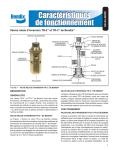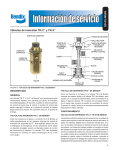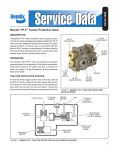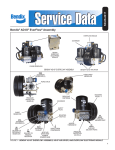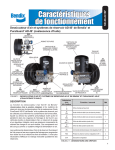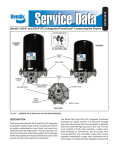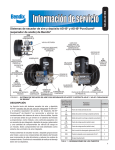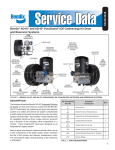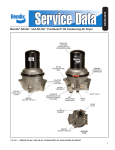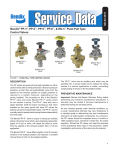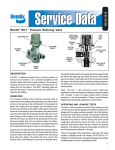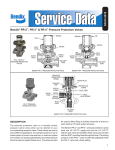Download BENDIX BW1581 User's Manual
Transcript
SD-03-4650 Bendix® TR-2™ & TR-3™ Inversion Valves SUPPLY PORT CAP NUT SEAL RING INLET & EXHAUST VALVE SPRING MOUNTING NUT & LOCKWASHER INLET & EXHAUST VALVE DELIVERY PORT (2) BODY PISTON GROMMET (SMALL) CONTROL PORT (3) PISTON PISTON SPRINGS PISTON GROMMET (LARGE) RETAINER RING EXHAUST COVER PLATE EXHAUST DIAPHRAGM DIAPHRAGM WASHER CAP SCREW FIGURE 1 - BENDIX® TR-2™ INVERSION VALVE DESCRIPTION GENERAL BENDIX® TR-3™ INVERSION VALVE Referring to Figure 2, the Bendix TR-3 valve is similar in function to the Bendix TR-2 valve, but with a die cast body. Referring to Figure 3, some TR-3 valves have an internal passage in the body connecting supply pressure to control. The external control port is permanently plugged in such valves. The Bendix® TR-2™ & TR-3™ valves are normally open, pilot-operated, inverting, on-off, two-way valves. As control pressure is reduced—to the point that the piston return spring or springs overcomes the force on the control piston—the valve will deliver full supply pressure at the delivery port. OPERATION BENDIX® TR-2™ INVERSION VALVE BENDIX TR-2 & TR-3 INVERSION VALVES Referring to Figure 1, the Bendix TR-2 valve was used primarily in early Bendix® DD-3™ safety actuator control systems. It applied air pressure to the emergency diaphragm of the DD-3 actuators from a protected reservoir as control pressure is released from the lock mechanism. The TR-2 valve is available in 1-1/4" bulk head-mount only. When sufficient air pressure is present in the control cavity to overcome the setting of the piston return spring, the piston is held away from the inlet valve which is, in turn, held closed by the inlet valve return spring. The delivery lines are vented to atmosphere through the hollow exhaust stem of the piston. When air pressure in the control cavity falls to a predetermined pressure—or is vented from the control cavity—the piston spring forces the piston against the inlet valve, closing the exhaust passage in the hollow piston stem. Further travel of the piston opens the inlet valve allowing the passage of air past the open inlet valve, and out the delivery port. 1 1/4” P.T. SUPPLY O-RING INTERNAL PASSAGE CAP VALVE SPRING VALVE STOP INLET & EXHAUST VALVE 1/8” P.T. CONTROL 1/4” P.T. DELIVERY O-RING SHIM PISTON O-RING DIAPHRAGM RETAINER EXHAUST NUT DIAPHRAGM PISTON SPRING EXHAUST FIGURE 2 - BENDIX® TR-3™ INVERSION VALVE The Bendix® TR-3™ valve, with the internal control passage functions the same as described in the previous paragraph. The only exception is that the control pressure is always the same as the supply pressure. Consequently, as supply pressure builds up, when the pressure is great enough to overcome the piston return spring, the delivery pressure will be vented out the exhaust. On descending supply/ control pressure, as the piston return spring overcomes the control pressure the valve will deliver the remaining supply pressure at the delivery port. MOUNTING LOCATION Care should be given to assure proper mounting location of the valve with the exhaust pointed downward (toward the road surface). It should be mounted high on the frame rail, and away from road spray and debris. Unprotected or exposed exhaust ports can allow migration of road contaminants into the valve, which may cause accelerated wear or unintended operation. PREVENTIVE MAINTENANCE Important: Review the Bendix Warranty Policy before performing any intrusive maintenance procedures. A warranty may be voided if intrusive maintenance is performed during the warranty period. No two vehicles operate under identical conditions, as a result, maintenance intervals may vary. Experience is a valuable guide in determining the best maintenance interval for air brake system components. At a minimum, the inversion valves should be inspected every six(6) 2 FIGURE 3 - BENDIX® TR-3™ INVERSION VALVE INTERNAL BLEED CONTROL months or 1500 operating hours, whichever comes first, for proper operation. Should the inversion valves not meet the elements of the operational tests noted in this document, further investigation and service of the valve may be required. The TR-3 valve is non-serviceable while the Bendix® TR-2™ valve can be serviced with a maintenance kit. For the latest service parts and kits, refer to the Bendix Quick Reference Catalog (BW1114) available for order or download at www.bendix.com OPERATING AND LEAKAGE TESTS NOTE: The following checks should be made with two calibrated gauges or two gauges known to be accurate. Depending upon installation, it may be easier or necessary to completely remove the valve to test properly. Install one test gauge in a common control and supply line; install the other gauge in the delivery port. Gradually apply pressure to the common supply and control line. On ascending pressure, note at what pressure exhaust occurs and compare with the vehicle manual. With air pressure present in supply and control ports, apply a soap solution to the delivery and exhaust ports. Leakage should not exceed 100 SCCM or a 1" bubble in 5 seconds. Excessive leakage would indicate a faulty o-ring or inlet valve. Slowly decrease pressure in the control cavity and note at what pressure delivery is made. Compare this with the vehicle manual notation. NOTE: In the Bendix® TR-3™ valve shown in Figure 3, control pressure is reduced by decreasing supply air pressure because of the internal passage connecting supply and control. ® If the Bendix TR-3 inversion valve does not function as described—or leakage is excessive—it is recommended that it be replaced with a new valve or remanufactured unit. The Bendix TR-2 valve can be serviced with a maintenance kit or replaced with a new or remanufactured valve. REMOVAL AND INSTALLATION REMOVAL Block and hold vehicle by means other than the air brakes. Drain service and emergency or parking reservoirs. Disconnect air lines from valve. Remove the mounting bolts, remove valve. INSTALLATION Remount valve securely using holes provided in body. Check and clean air lines and reconnect. GENERAL SAFETY GUIDELINES WARNING! PLEASE READ AND FOLLOW THESE INSTRUCTIONS TO AVOID PERSONAL INJURY OR DEATH: 5. When working on or around a vehicle, the following general precautions should be observed at all times. 6. 7. 1. Park the vehicle on a level surface, apply the parking brakes, and always block the wheels. Always wear safety glasses. 2. Stop the engine and remove ignition key when working under or around the vehicle. When working in the engine compartment, the engine should be shut off and the ignition key should be removed. Where circumstances require that the engine be in operation, EXTREME CAUTION should be used to prevent personal injury resulting from contact with moving, rotating, leaking, heated or electrically charged components. 3. Do not attempt to install, remove, disassemble or assemble a component until you have read and thoroughly understand the recommended procedures. Use only the proper tools and observe all precautions pertaining to use of those tools. 4. If the work is being performed on the vehicle’s air brake system, or any auxiliary pressurized air systems, make certain to drain the air pressure from all reservoirs before beginning ANY work 8. 9. 10. 11. on the vehicle. If the vehicle is equipped with a Bendix® AD-IS® air dryer system or a dryer reservoir module, be sure to drain the purge reservoir. Following the vehicle manufacturer’s recommended procedures, deactivate the electrical system in a manner that safely removes all electrical power from the vehicle. Never exceed manufacturer’s recommended pressures. Never connect or disconnect a hose or line containing pressure; it may whip. Never remove a component or plug unless you are certain all system pressure has been depleted. Use only genuine Bendix® brand replacement parts, components and kits. Replacement hardware, tubing, hose, fittings, etc. must be of equivalent size, type and strength as original equipment and be designed specifically for such applications and systems. Components with stripped threads or damaged parts should be replaced rather than repaired. Do not attempt repairs requiring machining or welding unless specifically stated and approved by the vehicle and component manufacturer. Prior to returning the vehicle to service, make certain all components and systems are restored to their proper operating condition. For vehicles with Automatic Traction Control (ATC), the ATC function must be disabled (ATC indicator lamp should be ON) prior to performing any vehicle maintenance where one or more wheels on a drive axle are lifted off the ground and moving. 3 BW1581 © 2011 Bendix Commercial Vehicle Systems Company LLC, a member of the Knorr-Bremse Group • 8/2011 • All Rights Reserved. 4




